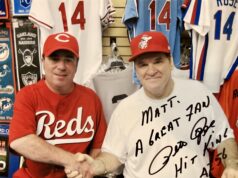
In 1985, UK student Kakie Urch wrote a column in the UK newspaper, the Kentucky Kernel, “Radio Free Lexington: What UK Needs.”
She didn’t write the column “to start a college radio station, but to be able to listen to one.”
“I was the UK Concert Co-chair and just loved music. Without a student radio station, I was spending most of my money on 
“We looked at the methods available on campus and decided to model ourselves after the most successful independent student media—the Kentucky Kernel. So we became a student organization with the Kernel, Student Government Association and Student Activities Board members on the first board. WRFL’s founding was a perfect example of collaboration between a number of student groups, UK administration, the community and local musicians. I like to say that WRFL was everyone’s good idea.”

At the 20th anniversary of the radio station, she reflected, “The WRFL playlist from an average disc jockey was in fact, the first iteration of the iPod playlist. Play what you like, what goes together in your world, whether it’s Patsy Cline into Husker Du into Robert Johnson into Active Ingredients into Calexico into Bill Monroe.”
Matt Dacey (these days enjoying a revival of Matt’s Metal Mortuary on Tuesdays on WRFL) recalls Lexington in the 80s, “There was only one rock station, and when they let their hair down, it was to play somebody like Night Ranger or Honeymoon Suite. I basically gave up on the radio and started spending a lot of my time and all of my money at Cut Corner records. I first learned of the movement to start a student-run radio station on campus during the Fall semester of 1986. It sounded cool, but I figured they would just play stuff like R.E.M. and the Beat Farmers all day long. It didn’t even occur to me at that point that they might actually play metal. Early in 1987, that changed.”
Dacey, in addition to being WRFL’s early resident metal guy, “was also the music librarian, and had the task of cataloguing and organizing the music library as we acquired it, sometimes hundreds of records at a time. That was my primary contribution to WRFL prior to going on the air. I also held the antenna as it was bolted down to the roof of the Patterson Office Tower.”
Urch, now an associate professor of multimedia at UK says today, “The station maintains the original spirit of collaboration, inclusiveness, innovation and excellence that we established in 1988, but has brought those values forward. For example, with the power increase to 7900 watts, the signal reaches five or six more counties. Live streaming audio and video bring local music, talk and eclectic programming to all corners of
the Internet. As podcasting comes to the fore, WRFL has a philosophy podcast, ‘Philosophy Bakes Bread,’ with more than 40,000 downloads. The Campus Voices news issues program produced by School of Journalism and Media students has won the top Public Issues Program in its division in the Associated Press awards.”
It’s come a long way.
—-
WRFL will celebrate its 30th anniversary with a long weekend of programming March 1 thru March 4. Friday’s Green Lantern show will include The Yellow Belts. Saturday March 3, from 1 pm to 4 pm, at the Downtown Arts Center in Lexington, a special exhibit of WRFL art over the years will be on display and the WRFL documentary “How It Went Down” will be shown followed by a panel discussion on the impact of college radio. Sunday’s brunch lineup at the Burl will include performances by 10 Foot Pole and 9 Lb. Hammer.
Subscribe to the Ace e-dition for Lexington news, food, arts, culture, and entertainment, delivered to your inbox every Thursday morning.





